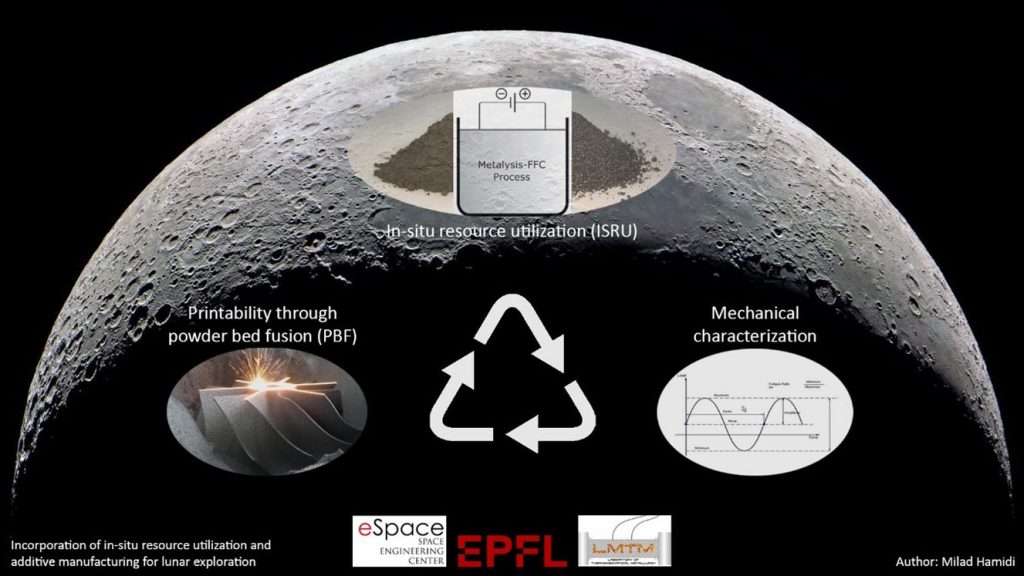M. Hamidi
To-date, all human economic activities have been contingent on the material and energy resources of earth, and it has long been recognized that developments in space exploration could essentially open our closed planetary economy to unlimited external resources of energy and raw materials. In other words, Sustainable and affordable exploration of the moon (and beyond) requires the production of consumables for autonomous or human activities from raw materials found in-situ on the moon or other planetary bodies, an approach known as In-Situ Resource Utilization (ISRU). The most important goal of ISRU is arguably the generation of oxygen from lunar materials for the sustainment of human life and propellant, as liquid oxygen is the largest mass component of many bipropellant rocket. Another key aspect of the ISRU is the production of metals from lunar materials so that lunar infrastructure may be established. Therefore, it would be advantageous to employ a process that allows for the production of both oxygen and metal. The long-term success of ISRU will only be ensured by keeping the “living off the land” vision while flying small payloads to the lunar surface to build up interest, expertise, and outreach in the space community.
Moreover, the incorporation of Additive Manufacturing (AM) into ISRU allows us to progress beyond the supply of consumables to the construction of complex objects using processed materials and layered construction. The products of the lunar ecology constitute feedstock for AM which provides a general-purpose manufacturing technique without the waste inherent to the more traditional subtractive techniques.
Based on the analysis of various Luna and Apollo samples, it is known that oxygen is the most abundant element in the lunar regolith, accounting for 40-45% by mass. However, this oxygen is chemically bound in the regolith material as oxides, in the form of minerals, and it is unavailable for immediate use. Other chemical and mineral resources such as metals are considered as valuable resources, particularly as they often are produced as by-products of extraction processes. Accordingly, after the oxygen extraction from the lunar regolith, a mixture of metallic and metalloid elements (e.g. Al, Ti, Fe, Mg, Ca, Na and Si) is left behind which could be utilized for the fabrication of the required structural parts on the lunar surface (and other planetary bodies).
AMISRU project is funded bilaterally by European Space Agency (ESA) – Open Space Innovation Platform (OSIP) and Swiss Space Center (SSC) – Mesure du Positionnement (MdP2020) for two years of study taking place jointly at Thermomechanical Metallurgy Laboratory (LMTM) and Space Center (eSpace) EPFL. The study focuses on the deep dive investigation of the laser-material (ISRU metallic by-product) interaction in terms of the governing thermo-mechanical and fluid-dynamical phenomena. The study employs an in-house Laser Powder Bed Fusion (LPBF) system incorporated with state-of-art laser beam manipulating module and in-situ observation technologies to acquire the maximal control over the laser-material interaction zone. Moreover, instead of conventional process optimization methods which require extensive amounts of trials and error, the project employs numerical analysis via Finite Element Method (FEM) and machine learning algorithms to minimize the required resources.

Laser processing of the ISRU metallic by-products could be dominantly challenging compared to the materials employed for LPBF to this date. This is due to the heterogenous chemical composition of these materials, high quantities of low vapor pressure elements such as Mg, Ca, Na and remaining oxygen from the extraction process. These characteristics can result in extensive element evaporation during the melt pool formation and result in massive exerted recoil pressure on the surface of the melt pool which could lead to melt pool instabilities to a level not seen before. The melt pool instabilities could result in generation of spatters, porosity and melt pool breakdown leaving behind a material with unsuitable levels of porosity and dimensional accuracy. Moreover, these feedstocks possess irregular powder geometries which could inhibit the flowability and spreadability of the feedstock on the powder bed; an added value to the complexity of the process.
Consequently, having maximum control on the process can significantly reduce the corresponding process challenges of ISRU metallic by-products. The project will also pay specific attention to the particular size distribution and geometry seeking improvement methods applicable on the corresponding feedstock. In addition, feedstock and build parts recyclability play an important role in the field of manufacturing in space which will be thoroughly investigated in the current project.
Finally, the project aims at full material and mechanical characteristics of the consolidated parts, stability of the process as a repeatable and reproducible approach.
AMISRU is part of a much larger roadmap which might extend to the next 10 years covering a number of potential processing technologies, design of novel metallic alloy systems based on the present elements on the planetary bodies of interest, etc.